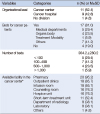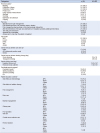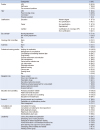Abstract
Purpose
This study to identify the current status of cancer centers in Korea in terms of organization ofhospital.
Methods
21 cancer centers, from regional cancer centers to the largest hospitals, were surveyed from October to November 2014. The questionnaire was developed by the board members of the Oncology Nursing Society.
Results
Centers specializing in cancer treatment were either cancer hospitals or centers affiliated with larger hospitals. 81% operated wards solely for cancer patients. The average number of beds was 354.2, and each center had independent laboratories, chemotherapy infusion rooms and pharmacies. Degree of nursing staff varied from grades 1 to 3. The nursing department and ward were jointly responsible for educating new nurses. In cancer nursing, the policy varied according to institution. For patient education, the oncology Advanced Practice Nurse (APN) mainly informed patients of the adverse effects of chemotherapy and central line care. 90.5% appointed oncology APNs, who were variously designated (47.6%). 10.5% of APNs held concurrent positions.
Figures and Tables
Table 1
Organization (N=21)

Table 2
Staffing of Oncology Nurses (N=21)

Table 3
Oncology Specific Nursing Care (N=21)

Table 4
Chemo Drugs Safety Protocol (N=21)

Table 5
Qualification and Task of Oncology Advanced Nurse Practitioner (N=19)

References
1. National Cancer Information Center. Cancer statistics. Accessed January 5, 2016. http://www.cancer.go.kr/mbs/cancer/subview.jsp?id=cancer_040101000000.
2. Ministry of Health & Welfare. Accessed July 15, 2016. http://ncc.re.kr/main.ncc?uri=english/sub04_Introduction.
3. Lee ER, Kwak MK, Kim EJ, Kwon IG, Hwang MS. Job analysis of korean oncology advanced practice nurses in clinical workplace: using the DACUM method. J Korean Oncol Nurs. 2010; 10:68–79.
4. Chae YH, Lee WH, Min YM, Shin AM, Kim HM. Nurse's role performance and perception of the importance of role among nurses practicing in a cancer care facility. J Korean Clin Nurs Res. 2013; 19:407–418.
5. Kim SH, Kim MY, Kim SH, Kim HK, Lee I, Lee J, et al. Trends of studies published in Asian Oncology Nursing, 2011~2014. Asian Oncol Nurs. 2015; 15:114–122.

6. National Cancer Center. Accessed November 24, 2016. http://ncc.re.kr/main.ncc?uri=manage01_6.
7. Health Insurance Review & Assessment Service. Accessed November 24, 2016. http://webzine.koreanurse.or.kr/Webzine2014/read_article.php?webzine_id=44&sub_cat_id=458&is_sub_no=756&article_id=1003.
8. You OS, Park JH. Effect of planned indoctrination program on role transition of new graduate nurses. J Korean Acad Nurs Adm. 1998; 4:129–150.
9. Hospital Nurses Association. Accessed November 24, 2016. http://www.khna.or.kr/web/information/resource.php.
10. Ji SA, Jeon CY, Kim HJ. Nursing management. Paju: Soomoonsa;1990.
11. Korea Institute of Healthcare Accreditation. Accessed November 5, 2016. http://www.koiha.kr/member/kr/board/establish/establish_BoardList.do.
12. Moon AR. Nurses knowledge and compliance on guideline for safe handling of cytotoxic drugs and its associated factors [dissertation]. Seoul: Korea Univ.;2010.
13. Jeong KW. State of safety management among nurses handling anticancer drugs and their awareness and performance of safety regulations [dissertation]. Chuncheon: Hallym Univ.;2011.
14. Korean Accreditation Board of Nursing Education. Advanced practice nurse education institution appointment and evaluation. Accessed August 11, 2016. http://kabone.or.kr/kabon05/index02.php.
15. Kim MY, Park SA. A methodology research of performance appraisal tool of oncology advanced practice nurse. J Korean Acad Nurs Adm. 2007; 13:17–23.
16. Kim SH, Ham YH, Kim JH, Kim HK, Hwang OH, Kim MY, et al. Satisfaction with Korean oncology advanced practice nurses' role: a study of patients, physicians, and nurses. Asian Oncol Nurs. 2014; 14:41–49.

17. Tae YS, Kwon S, Lee YS. The job experience of oncology nurse specialists. Asian Oncol Nurs. 2014; 14:236–248.

18. Lee TW, Ko IS, Kim IS, Kim HO, Park YW, Kim IJ, et al. Development of roles and organizational policy of advanced practice nurse in an acute hospital setting. J Korean Acad Nurs Adm. 2007; 13:352–361.




 PDF
PDF ePub
ePub Citation
Citation Print
Print


 XML Download
XML Download